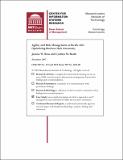| dc.contributor.author | Ross, Jeanne W. | |
| dc.contributor.author | Beath, Cynthia M. | |
| dc.date.accessioned | 2011-10-21T18:37:47Z | |
| dc.date.available | 2011-10-21T18:37:47Z | |
| dc.date.issued | 2007-12-01 | |
| dc.identifier.uri | http://hdl.handle.net/1721.1/66532 | |
| dc.description.abstract | Pacific Life is a diversified financial services company with a history of autonomous business units. Pacific Life had five independent divisions, including Life Insurance, Annuities and Mutual Funds, and Investments. These divisions served different customers and responded to different regulatory and market requirements. Pacific Life executives embrace decentralization as the best structure for capturing excellence in the individual businesses, so they are willing to sacrifice some potential efficiencies. But while they are usually willing to forego the benefits of a more centralized organization structure, they are not willing to assume any unnecessary risks. This case describes how the company governs shared IT services and enterprise risk management to limit its risk exposure while reaping the benefits of decentralization. | en_US |
| dc.language.iso | en_US | en_US |
| dc.publisher | Cambridge, MA; Alfred P. Sloan School of Management, Massachusetts Institute of Technology | en_US |
| dc.relation.ispartofseries | MIT Sloan School of Management Working Paper;4692-08 | |
| dc.relation.ispartofseries | CISR Working Paper;372 | |
| dc.subject | agility | en_US |
| dc.subject | risk | en_US |
| dc.subject | shared services | en_US |
| dc.subject | IT governance | en_US |
| dc.title | Agility and Risk Management at Pacific Life: Optimizing Business Unit Autonomy | en_US |
| dc.type | Working Paper | en_US |
